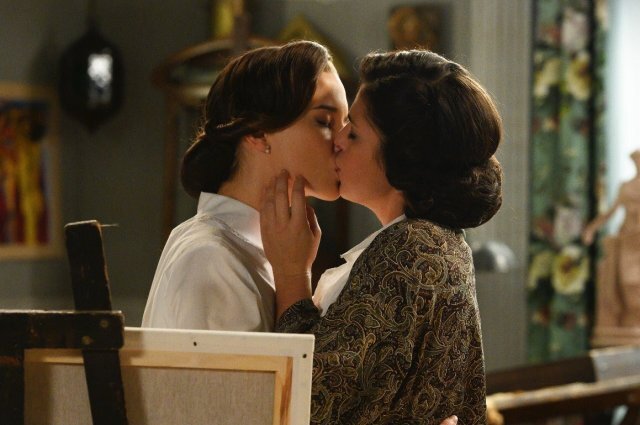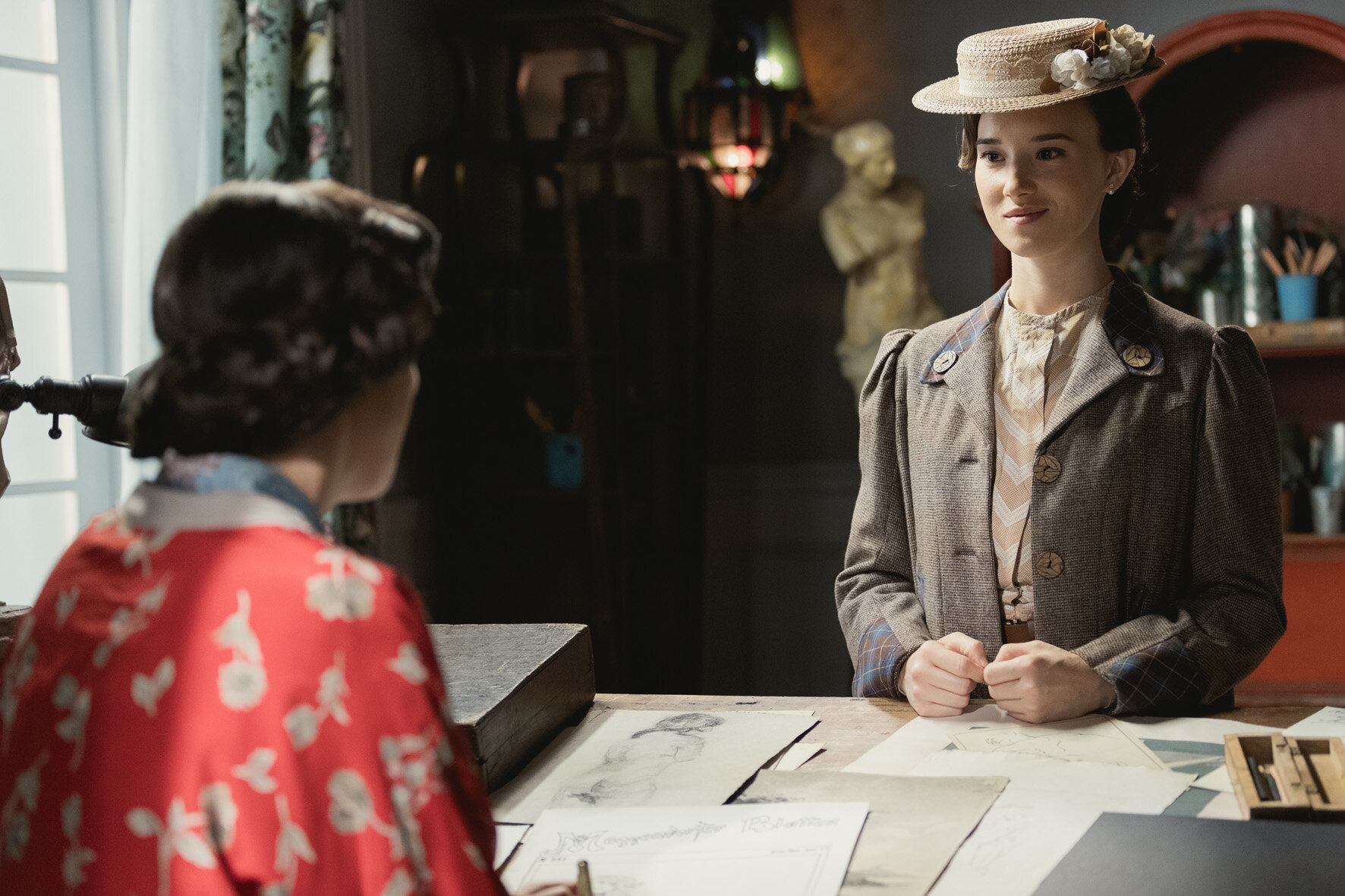By: Karen Frost
Ecosystem: a large community of living organisms that live in an interconnected network in a symbiotic, balanced relationship to each other.
Looked at scientifically, TV fandoms are ecosystems. They are vibrant, colorful, dynamic communities that connect individuals across time and geography into an ever-changing, adaptive network. Like all ecosystems, they are symbiotic: fans derive energy from the TV show they love, which they then reflect back into the system. The show and the actresses associated with it absorb this fan energy and channel it into further production in an iterative feedback cycle. Or to use a different analogy, the fan-show relationship is like a fire on a cold day: the more wood fans pile on, the hotter the fire burns, and the warmer they get. As a music fan recently noted, fans are essential to the success of a project, but fandoms take that success to stratospheric levels.
There are three components to TV fandom ecosystems: the fans, the cast, and the social media/PR. This article describes how these components work together in the ecosystem to create a positive, symbiotic relationship. It uses the Maitino fandom (which is associated with the lesbian couple Maite and Camino on the Spanish show “Acacias 38”) as a case study to show these ideas. The overall point is: fandoms are dynamic. With intentional acts, they can be grown. The most successful fandoms likely are successful because all three components work together in synchronicity. So for anyone who is a member of one of these three components, the potential exists to take what is already good and make it even better just by adding additional energy to the ecosystem.
Component 1: The Fans
It’s self-evident that a TV show with no fans is cancelled immediately. Viewers are essential to any project. But not all viewers are fans and not all fans are able to create a robust fandom. Below is a breakdown of what fans bring to the fandom ecosystem, what they receive from it, and the two key figures that emerge in lesbian TV fandoms to help nurture and grow the fandom.
What fans bring to the ecosystem: According to the most widely accepted etymology, the word “fan” is a shortened version of the word fanatic, which means “marked by excessive enthusiasm and often intense devotion.” What differentiates casual viewers from fans is that the fanaticism of fans becomes part of their personal identity. They attend conventions, comment on social media, hang up posters, wear shirts, go to fan events, create fan fiction/art/videos, etc. They put up billboards in Times Square supporting their favorite actresses and use online campaigns to get shows renewed for additional seasons. Fans bring passion, energy, and size to the ecosystem, which can lead to awards nominations, shows lasting longer, and storylines being extended.
Queer female TV fans in particular are a large and vocal group. They span the globe, transcending nationality, language, and continents. Although the mainstream hasn’t realized it yet for the most part, queer female fans have created some of the most fertile TV fandom ecosystems in the world. (It’s one reason I’ve encouraged shows to add more lesbian couples.) Queer women number in the millions and they’re hungry for representation. They bring to their fandom ecosystems unbridled passion and huge numbers.
How many lesbian TV fans are there? It’s impossible to know exactly, but they make a huge impression everywhere they go. In a recent interview, for example, the creators of the webseries #Luimelia, which gave the lesbian pairing of Luisita and Amelia from the Spanish show “Amar es Para Siempre” its own mini spin-off, noted that Tweets mentioning Luimelia produced more than 40 million impressions during the 2018/2019 season, which was ten times as many impressions as the show got the previous season. Here are several Maitino social media metrics that show the impact of queer female fans:
Twitter: Per the hashtag tracking site Talkwalker, from 13-20 February, there were 30,900 Twitter conversations mentioning “Maitino,” with a potential reach of 135.2 million Twitter users. For context, that’s almost triple the population of Spain (46.7 million). On 17 February, #LaResistenciaMaitino topped 16,000 tweets.
YouTube: Maitino’s top viewed video, “Acacias 38: La primera vez de Camino y Maite #Acacias1161” (“Acacias 38: The first time for Camino and Maite”), has 1.88 million views, making it the sixth most watched YouTube video for @RTVESeries’ YouTube channel and the most watched “Acacias 38” video.
Instagram: Aria Bedmar (who plays Camino) mentioned in an interview that after the first Maitino kiss aired, she suddenly started getting thousands of new Instagram followers a day. As of this writing, she has 27,100 followers. Ylenia Baglietto (who plays Maite) has 15,400. The show’s official Instagram handle only has 15,200 followers, while Susana Soleto, who plays Camino’s mother, has 2,381 followers.
What fans receive from the ecosystem: In the Internet era, fandoms have turned what was once a passive, largely individual event (sitting at home watching TV) into a shared, participatory online communal experience. Watching what happens on a TV screen is only a fraction of that experience. Fandoms offer community, active engagement with the material, and even the chance to interact with the actresses. It’s an opportunity to become part of a greater whole. Particularly for the LGBT community, fandoms might be the only contact they have with other queer individuals. It is a safe space where they can share emotions, discuss their lives, and feel represented.
Two key fan types grow the fandom: The biggest lesbian TV fandoms have hundreds of thousands if not millions of fans around the world. But not all fans play the same role in the fandom. Based on observation, two key figures quickly emerge in most fandoms that act as natural rally points for fans. These figures encourage the ecosystem’s growth by raising the visibility of the fandom online. They are:
1. The “First Mate”: All fandoms have cheerleaders. Naturally, fans love their fandom and want to shout about how great it is. But in every fandom there are one or more figures with enough clout to lead the fandom. Like free PR, they are consistently active on social media and use hashtagging to raise the fandom’s visibility in the wider queer community. Other fans seek out their opinions and reactions, leading them to gain hundreds or thousands of followers of their own. The cast may reTweet them and the crew might even develop an informal relationship with them. I call these figures the “First Mate.” (A word of explanation: queer women tend to follow “ships”—the short form of “relationship”—meaning they’re more often fans of specific romantic pairings on a show vice the overall show itself. The actresses who play the relationship on TV are dubbed the “Ship Captains,” and hence I created the term “First Mate” to continue the nautical metaphor.)
Normally, First Mates are not related to anyone on the show. They may not even live in the same country where the show is airing. In what is likely the first example of its kind, one of Maitino’s First Mates is Kenzy Loevett, Bedmar’s wife. This is an exciting, unique scenario. Although Bedmar is not the first queer actress in a popular queer role (Zoie Palmer in “Lost Girl” and Michelle Hardwick in “Emmerdale” immediately spring to mind), this is the first time a significant other (queer or straight) has been a First Mate, to my knowledge. And it’s the epitome of fandom symbiosis, to the benefit of the Maitino fans. In addition to “fangirling” and leading Twitter hashtag campaigns, as all First Mates must, Loevett provides fans indirect access to Bedmar and Baglietto by posting behind the scenes videos and pictures.
Bedmar and Loevett’s wedding photo from @aria_bedmar’s Instagram
2. The Translators: Lesbian fandoms are always international. The larger the fandom, the more languages clips of the show have been translated into. Maitino, for example, has translations in at least English, French, Italian, Thai, Turkish, Russian, Portuguese, Chinese and German. Translators are a key component of the ecosystem, worth their weight in gold. Most fandoms only have one or two people who translate and subtitle in each language. Without translators, a fandom will be limited in how large it can grow internationally.
Component 2: The Cast
To many people, “fandom” is just another word for “fans,” but this narrow understanding of the concept marginalizes the role that the cast and the show’s social media/PR play in the ecosystem. In point of fact, the cast and social media/PR play a significant role in the success of a fandom. The more involved they are, the more symbiotic the relationships in the ecosystem and the more robust the fandom ecosystem becomes.
In the case of lesbian TV fandoms, the “cast” boils down to the two actresses in the lesbian pairing. This is both a boon and a curse. On the plus side, the actresses benefit from the boisterous, undiluted energy of the fans. The downside is that the intense fan focus places the burden of engagement exclusively on them. Because the spotlight never shifts away from them, there is a constant appeal to their attention, forcing them to decide how much time and energy they’re able to commit to interacting with the fandom.
What the cast brings to the ecosystem: If fans bring numbers and energy to the fandom, the actresses bring (on top of their regular acting duties) enthusiasm for the fandom and some degree of personal accessibility. In the best case scenario, actions taken by the actresses show fans they care about the fans and the fandom. The fans feel that they are “seen” by the actresses and that everyone is part of a single community pulling together for a greater cause. What these actions look like in practice varies significantly, but for the most part involves some combination of responding to and reTweeting fan Tweets, Tweeting about things happening in the actresses’ personal lives, posting behind the scenes fandom shots to Instagram, and participating in fandom-centric interviews.
Bedmar and Loevett’s social media use is a classic and highly effective example of engaging with fans on social media to create a shared fandom community/experience. Bedmar has responded to fan art on Twitter, reTweeted interviews, and posted behind the scenes Maitino photos to Instagram. Bedmar and Loevett’s joint Instagram account, @wearekenzaria, cheerleads Maitino while also sharing a positive queer (real life) love story with followers. Going above and beyond, Bedmar and Loevett consistently create Instagram stories for the fans, and Loevett even created “Caillat/me” fan shirts. Baglietto, meanwhile, maintains a lower personal profile, but is a prolific reTweeter of Maitino news articles.
In the past, I’ve written how actresses can contribute to the fandom ecosystem, using case studies drawn specifically from actresses on TV shows (for AfterEllen and GayBaeCo). The basis for those articles stands: lesbian TV fandoms can and do exist without the engagement of their actresses, driven by the energy of just the fans, but the higher the cast engagement, the more enthusiastic the fandom. Put another way, a “ship” will sail with no “captain,” but it sails better when the actresses actively captain their ship.
What casts receive from the ecosystem: In almost two decades of interviews with actresses in queer roles, the all but universal consensus is that actresses who have played a queer character derive profound personal gratification from the outpouring of support they receive from fans. In Tweets, letters, emails and cards, these actresses receive thousands of messages of support and love (and inevitably, some stalkers). Unequivocally, there is no parallel when playing heterosexual roles. It is therefore a once in a lifetime experience. The impact of being part of a robust fandom can be professional, too. Around the world, actresses in queer TV roles have won national acting awards, been promoted from recurring to regular cast members, and seen their social media followers skyrocket, all of which can have tangible benefits for their prospects for casting in future roles.
Component 3: The Social Media/PR
The role of a TV show’s PR is probably the least recognized part of fandom, and yet in the last few years, social media has drastically increased this role. Now a show’s official social media accounts can be just as much a part of the fandom as the fans themselves. These accounts act at various times as cheerleaders, PR, and fans. Showrunners (like Emily Andras of “Wynonna Earp”) and writers (like Javier Grillo-Marxuach of “The 100”), too, can become part of the fandom, although this article will not discuss them.
What the PR/social media brings to the ecosystem: The PR department of TV shows bring to the fandom a pre-established social media platform and industry connections, which they can use to help grow the fandom by raising its profile. The department can arrange actress interviews, organize behind the scenes material, and compile “best of” scenes, keeping fans engaged and rewarded. Here are some examples of what RTVE and “Acacias 38” have done for the Maitino fandom:
Twitter: When it comes to the Twitter account for “Acacias 38,” Maitino is the undisputed king. Are there even any other couples on “Acacias 38”? You wouldn’t know from its Twitter feed. The pinned Tweet for the @acacias38_rtve account is an interview between Baglietto and Bedmar. Some 90% of the tweets originating from the account have either Camino or Maitino as the thumbnail photo. The account has a red ribbon in its handle, a nod to Maitino, and the account regularly tweets with the hashtags #Maitino and #Maitiners.
YouTube: In addition to uploading interviews with Bedmar and Baglietto, "Acacias 38” has created specific Maitino fanvideos for YouTube. “Acacias 38: Maite y Camino, la historia de un amor prohibido #Acacias38” (“Acacias 38: Maite and Camino, the story of a forbidden love”), has 1.4 million views. “Acacias 38: Los mejores momentos de #Maitino #Acacias38” (“Acacias 38: The best moments of #Maitino”) also has 1.1 million views.
What the PR/social media receives from the ecosystem: Popular lesbian TV fandoms produce massive amounts of social media buzz, and as they say in America, “All publicity is good publicity.” The average Tweet from @acacias38_rtve about a non-Maitino topic generates around 75 likes and six reTweets, but Maitino tweets average over 300 likes and over 50 reTweets. By every social media metric, Maitino is by far the most popular couple on “Acacias 38” right now, and this popularity recently garnered Bedmar and Baglietto an interview with Vodaphone Yu. Large fandoms mean more publicity for the show, which means more viewers and more ad revenue.
Growing the Fandom
Together, the fans, the actresses, and the social media/PR of a show can create a fandom capable of touching thousands and even millions of people around the globe. For queer women, these fandoms are oases of community in a still largely homophobic world. As a parting thought, fandoms grow when new fans are drawn in. Fandoms like Maitino that are still in the nascent stages can grow exponentially by hooking into other fandoms. A smaller ecosystem can grow by tapping into a larger one. Besides, fans can’t watch what they don’t yet know exists. So for any new fandoms, perhaps the fastest way to grow is not to just use fandom exclusive hashtags, but to use the hashtags of other fandoms as well. After all, each fandom is one ecosystem in a much, much larger global lesbian ecosystem. #Juliantina #Luimelia #WayHaught #Creampuff #Flozmin #Barcedes











